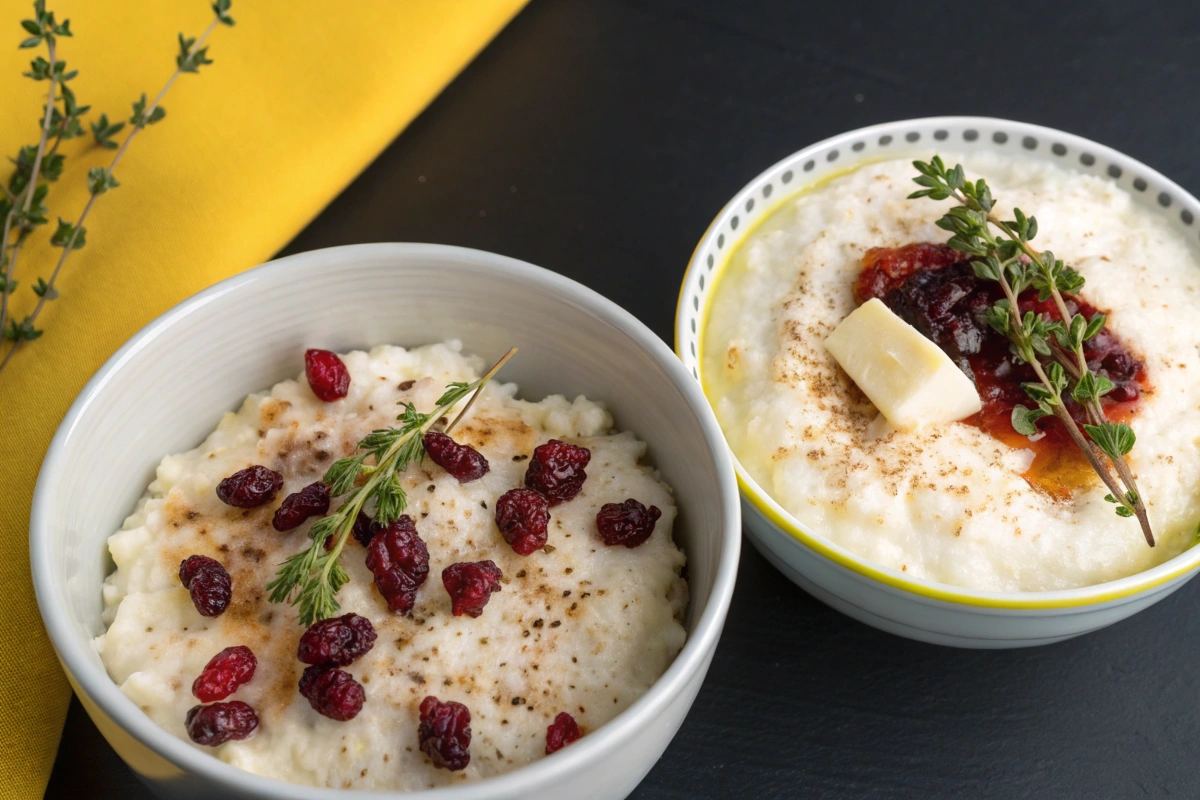Rice Pudding vs Cream of Rice: What Sets Them Apart?
Have you ever wondered why rice pudding and cream of rice are so different, despite both being rice-based dishes? At first glance, they might seem similar, but each has unique characteristics that make them distinct. These differences stem from their origins, ingredients, and preparation methods. Understanding their uniqueness can help you decide which one to make for your next meal or occasion.
In this article, we’ll explore the fascinating histories of rice and cream of rice, compare their ingredients, and look at how to prepare them. By the end, you’ll see why both deserve a special place in the culinary world.

Table of contents
- Rice Pudding vs Cream of Rice: What Sets Them Apart?
- The History of Rice Pudding and Cream of Rice
- Key Ingredients in Rice Pudding and Cream of Rice
- Differences in Preparation Methods
- Is Rice Pudding the Same as Cream of Rice?
- Nutritional Comparisons
- Similarities Between Rice Pudding and Cream of Rice
- Conclusion
- FAQ
The History of Rice Pudding and Cream of Rice
Rice–pudding and cream–of–rice may share a common ingredient, but their histories are vastly different. While rice pudding has been a celebrated dish for thousands of years, cream of rice emerged much later as a practical, nutritious food. Let’s explore how these dishes came to be.
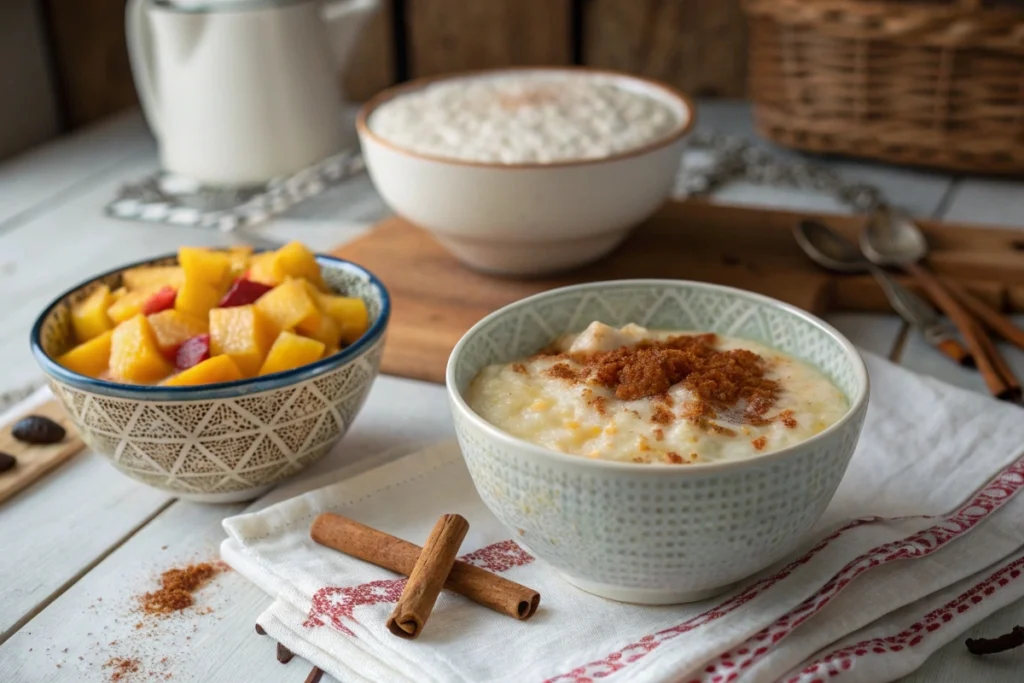
Origins of Rice Pudding
The story of rice pudding began in ancient India around 6000 BC, where it was first called Kheer. Over time, this dish spread to other parts of the world, evolving with each culture. By the 1300s, rice pudding had reached Europe, where it was initially made as a savory dish. Eventually, sugar and spices were added, transforming it into the sweet dessert we know today.
Moreover, rice pudding became a symbol of celebration and hospitality in many countries. For example, in Denmark, rice pudding, or “risalamande,” is a traditional Christmas Eve dessert, often served with a hidden almond for good luck.
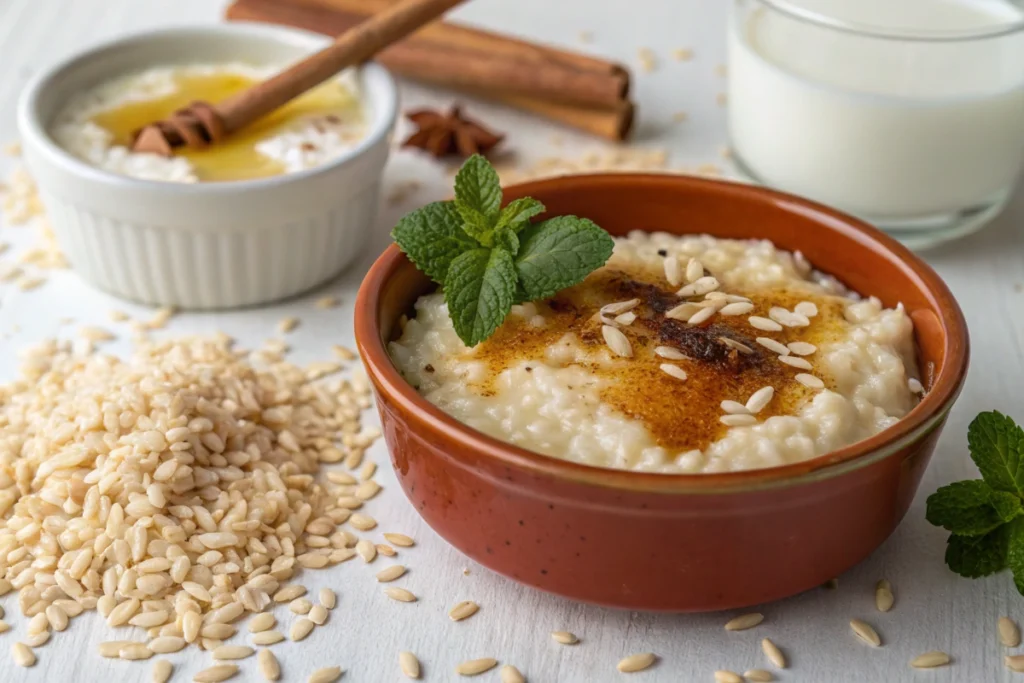
How Cream of Rice Came to Be
Unlike rice pudding, cream of rice has a shorter history. It was developed in the early 1900s as a smooth, easy-to-digest cereal made from finely ground rice flour. This dish was initially designed for infants and people recovering from illnesses. Its simplicity, quick preparation, and mild flavor made it a staple in many households.
When comparing rice pudding vs cream of rice, their purposes become clear. Rice pudding is a sweet, festive dessert, while cream of rice is a versatile, nutritious breakfast or comfort food.
| Characteristic | Rice Pudding | Cream of Rice |
|---|---|---|
| Origins | Dates back to ancient India, known as Kheer | Developed in the early 20th century |
| Main Ingredients | Rice, milk, sugar, and spices | Enriched rice flour and water |
| Texture | Soft and creamy | Smooth and porridge-like |
| Purpose | Dessert and festive dish | Nutritious cereal for infants and invalids |
| Cultural Significance | Used in celebrations and religious events | Focuses on health and dietary needs |
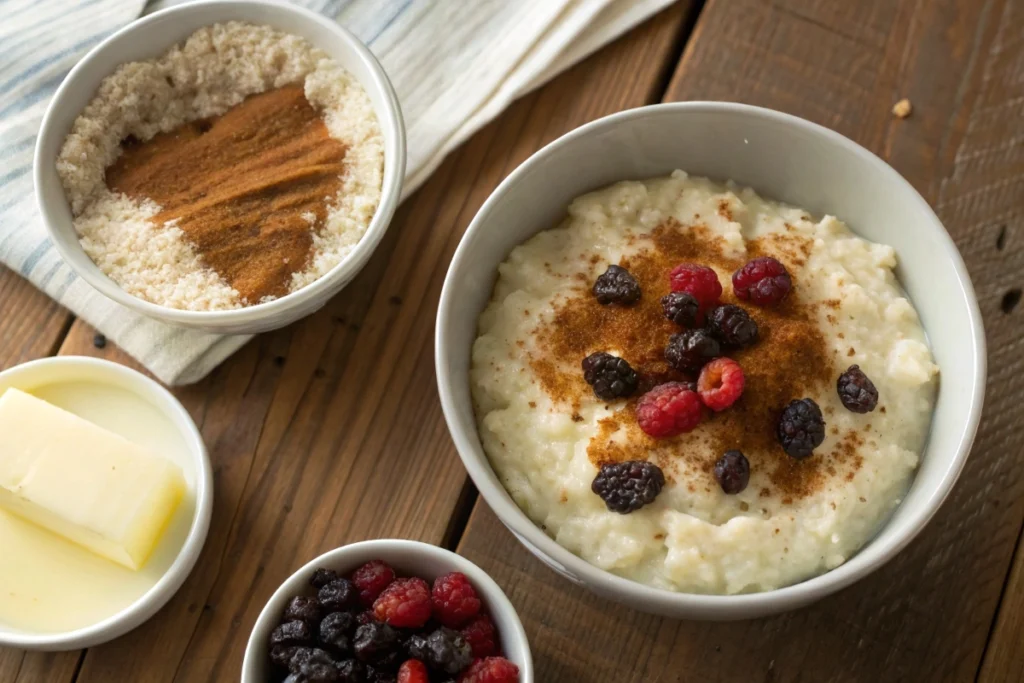
Key Ingredients in Rice Pudding and Cream of Rice
Looking into the main ingredients of rice pudding and cream of rice shows their unique sides. Both dishes use rice, but they have different ingredients and tastes. Let’s explore what makes each dish special.
Common Ingredients in Rice Pudding
Rice pudding is made with a mix of ingredients that make it creamy and tasty. The main parts are:
- 1 cup of white rice, like Arborio for creaminess.
- 6 cups of whole milk for richness.
- 3 tablespoons of sugar for sweetness.
- Spices like cinnamon and nutmeg for warmth.
- A single almond, hidden traditionally, for fun.
This dish is cooked for about an hour. It makes the rice soft. It’s a favorite, especially in Denmark during Christmas Eve.
Ingredients in Cream of Rice
Cream of rice focuses on different ingredients and nutrition. The main parts are:
- Enriched rice flour, with vitamins and minerals.
- Water or milk for a smooth texture.
This dish is not as sweet or spicy as rice pudding. It’s more for breakfast, with a simple taste. Rice pudding is richer and dessert-like, while cream of rice is lighter.
A rustic kitchen countertop with bowls of key ingredients for rice pudding – white rice, creamy milk, sugar, a sprinkle of cinnamon, a handful of raisins, and a vanilla bean pod, surrounded by wooden spoons and a small pot simmering on the stove, warm natural light illuminating the scene.
Differences in Preparation Methods
Learning how to make rice pudding and cream of rice can enhance your cooking repertoire. Both dishes offer unique preparation styles that cater to different preferences. While rice pudding requires more time and effort, cream of rice is quick and straightforward. Despite these differences, both dishes are versatile and have their own charm, appealing to diverse tastes.
Cooking Techniques for Rice Pudding
The type of rice you choose significantly impacts the taste and texture of your rice pudding. For instance, basmati rice adds a delicate fragrance, while Arborio rice creates a creamy consistency. On the other hand, brown rice offers a nutty flavor, although it results in a chewier texture.
When preparing rice pudding:
- Combine rice, milk, sugar, and spices in a pot over medium heat.
- Stir frequently to prevent sticking or burning.
- Allow the mixture to cook for 30 to 45 minutes, letting the flavors meld together.
It’s essential to avoid overcooking, as this can lead to a mushy texture. To make a dairy-free version, substitute regular milk with coconut milk or almond cream. This not only makes the pudding richer but also suits dietary restrictions. Serve it warm for a comforting dessert, or chill it for a refreshing treat. Either way, the result is a delicious, creamy delight.
How to Prepare Cream of Rice
In contrast, cream of rice is far simpler to prepare. This dish relies on finely ground rice flour, making it quick and easy to cook. Here’s how you can make it:
- Boil water or milk in a saucepan.
- Gradually whisk in the rice flour to prevent lumps.
- Continue stirring for a few minutes until the mixture thickens to a porridge-like consistency.
This method is not only fast but also beginner-friendly, making it an excellent choice for busy mornings or light meals.
Moreover, cream of rice can be easily customized with toppings to suit your taste. For example, you can enhance its flavor with fresh fruits, a sprinkle of cinnamon, or a handful of nuts. You might even drizzle honey or maple syrup for added sweetness. These options make it a versatile choice for those seeking something nutritious yet adaptable.
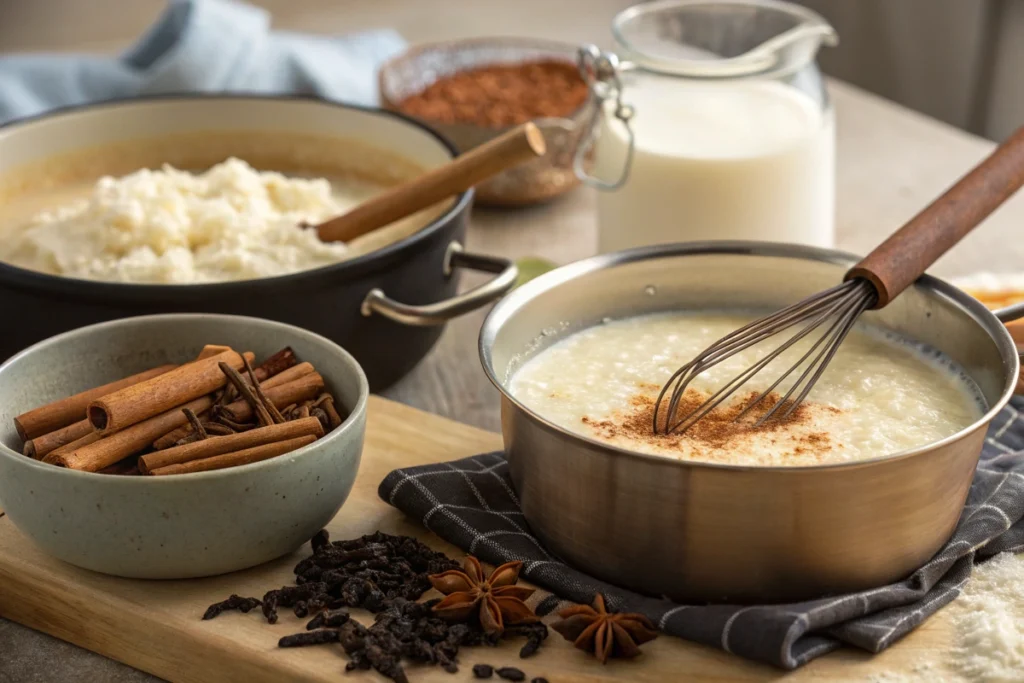
Is Rice Pudding the Same as Cream of Rice?
When comparing rice pudding and cream of rice, it’s clear they are distinct in taste, preparation, and nutritional value. While they both originate from rice, these dishes serve entirely different purposes and cater to varied culinary preferences. Exploring their unique qualities and origins reveals why each has a special place in the world of food.
Culinary Distinctions
The culinary differences between rice pudding and cream of rice are significant.
Rice pudding is primarily a sweet dessert, often enjoyed warm or chilled. Its creamy texture comes from a combination of milk, sugar, and spices like cinnamon or nutmeg. For an extra twist, many traditional recipes incorporate unique regional flavors. For example, the Portuguese dish Arroz Doce adds lemon zest, enhancing its fresh and zesty appeal. This attention to flavor makes rice pudding not just delicious but also visually enticing, often garnished with cinnamon or raisins.
In contrast, cream of rice is a neutral, mild-flavored dish typically served as a breakfast or comfort food. Made from ground rice and either water or milk, it lacks the added sugar and spices found in rice pudding. Its smooth, porridge-like consistency makes it easy to digest, which is why it’s commonly recommended for babies or individuals with dietary restrictions. The lack of sweetness gives it flexibility, allowing the addition of toppings like fresh fruits, nuts, or a drizzle of honey to enhance its flavor.
Thus, while rice pudding delights as a decadent dessert, cream of rice serves as a versatile and nutritious staple for lighter meals.
Nutritional Comparisons
From a nutritional perspective, these dishes cater to different needs:
- Rice pudding is richer and more indulgent. The inclusion of sugar and dairy significantly increases its calorie count. With higher levels of carbohydrates and fats, it’s a satisfying option for those craving a decadent dessert. However, it’s less suitable for those on a calorie-conscious diet.
- Cream of rice, on the other hand, is lower in calories and has a simpler composition. Despite being lighter, it still provides essential nutrients like carbohydrates for energy. Additionally, it can be prepared with fortified rice flour, making it a good source of vitamins and minerals. This makes it an excellent choice for those prioritizing health and dietary balance.
Similarities Between Rice Pudding and Cream of Rice
While rice pudding and cream of rice are distinct in many ways, they share several commonalities that make them beloved comfort foods around the world. Their simplicity, versatility, and nutritional benefits contribute to their universal appeal. Exploring these similarities sheds light on why they remain staples in kitchens across cultures.
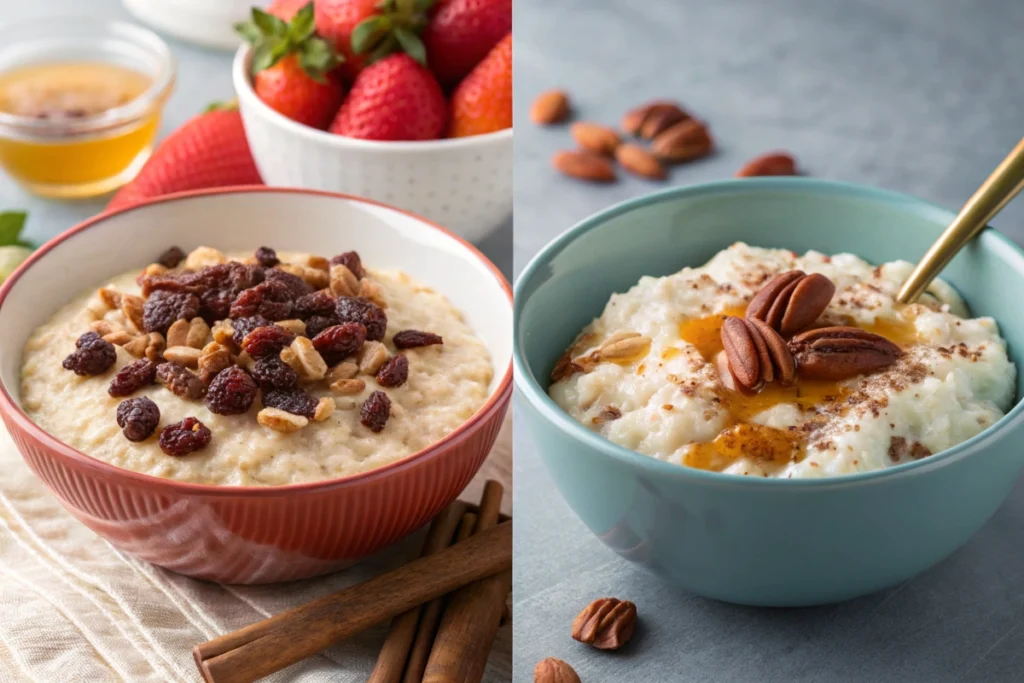
Shared Nutritional Benefits
One of the most notable similarities between these dishes is their ability to provide energy. Both rice pudding and cream of rice are excellent sources of carbohydrates, making them ideal for fueling the body. In addition, when prepared with dairy, they contribute calcium, which supports strong bones and overall health.
Another shared characteristic is their ease of digestion. These dishes are gentle on the stomach, making them suitable for individuals of all ages, including children, older adults, and those with sensitive digestive systems. For anyone recovering from illness, their simplicity and soft textures provide a soothing meal option.
Moreover, their preparation methods ensure they are both enjoyable and straightforward to make. Whether you’re whipping up a batch of creamy rice pudding for dessert or a bowl of warm cream of rice for breakfast, these dishes deliver comfort with minimal effort.
Variations and Adaptations
Although their base ingredients are simple, both rice pudding and cream–of-rice are highly versatile. They can be easily customized to suit different tastes and cultural preferences. For example, rice pudding can be elevated with the addition of fruits, nuts, or aromatic spices like cardamom, cinnamon, or nutmeg. In some regions, it is even infused with rose water or saffron for a luxurious twist.
On the other hand, cream of rice adapts well to both sweet and savory flavors. For a breakfast treat, you might add fresh berries, honey, or maple syrup. Alternatively, savory toppings like herbs, sautéed vegetables, or a poached egg can transform it into a hearty, satisfying meal. This adaptability allows home cooks to experiment and create personalized versions of these timeless dishes.
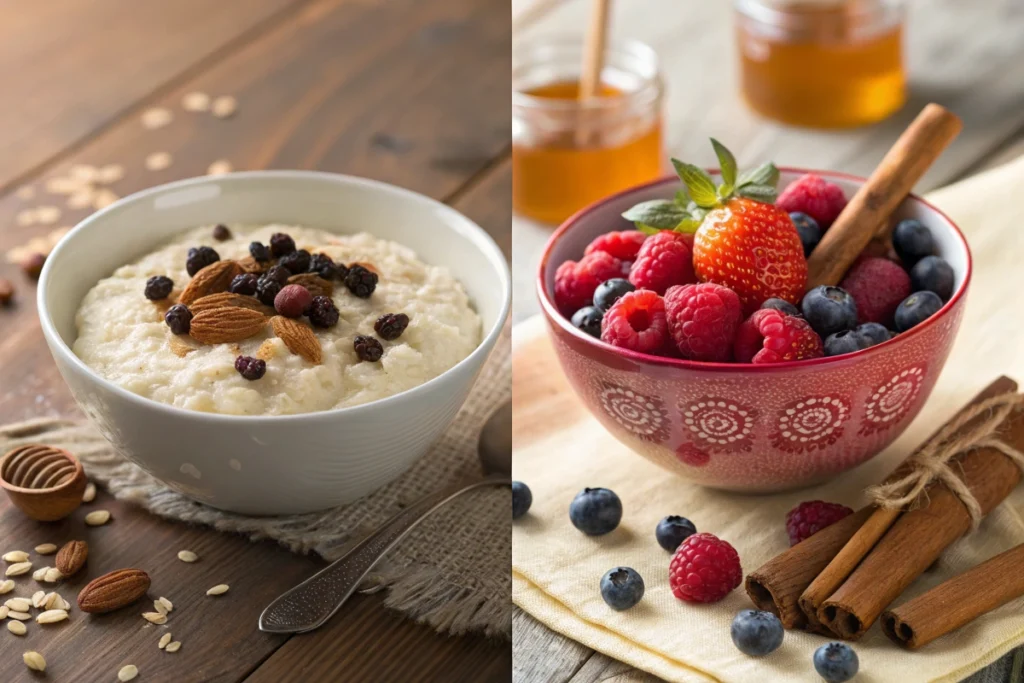
A split image showcasing a creamy bowl of rice pudding on one side, rich with cinnamon and raisins, and a smooth bowl of cream of rice on the other, garnished with fresh berries and a drizzle of honey, both set on a rustic wooden table with soft natural lighting, highlighting their textures and colors.
Conclusion
Understanding the differences between these two dishes is important for food enthusiasts who enjoy comforting and versatile meals. Both rice pudding and cream of rice come from different culinary traditions, offering their own unique appeal. Rice pudding is celebrated for its creamy texture and adaptability, allowing for the addition of spices and various toppings. In contrast, cream of rice is prized for its smooth, light consistency and the ease of its quick preparation.
When making rice pudding, the process typically takes about 30–40 minutes. During this time, the rice becomes tender, and the flavors blend beautifully. Moreover, regional variations, such as the addition of cinnamon in Mexican recipes or lemon zest in Spanish versions, highlight how much people love this dish across the globe. These adaptations not only enhance its flavor but also connect us to diverse cultures.
On the other hand, cream of rice is faster to prepare and can serve as a versatile base for many recipes. Its neutral flavor allows it to be easily paired with sweet or savory toppings, making it a practical choice for busy mornings or light meals. For creative inspiration, visit QuicklyTasty.com to explore ideas for breakfast bowls or desserts.
Ultimately, special places in the world of comfort food. Understanding their differences helps us appreciate the distinct roles they play in our meals. If you’re looking to try a traditional, sweet dessert, rice pudding might be the perfect choice. Alternatively, for a quick and adaptable dish, cream of rice is an excellent option.
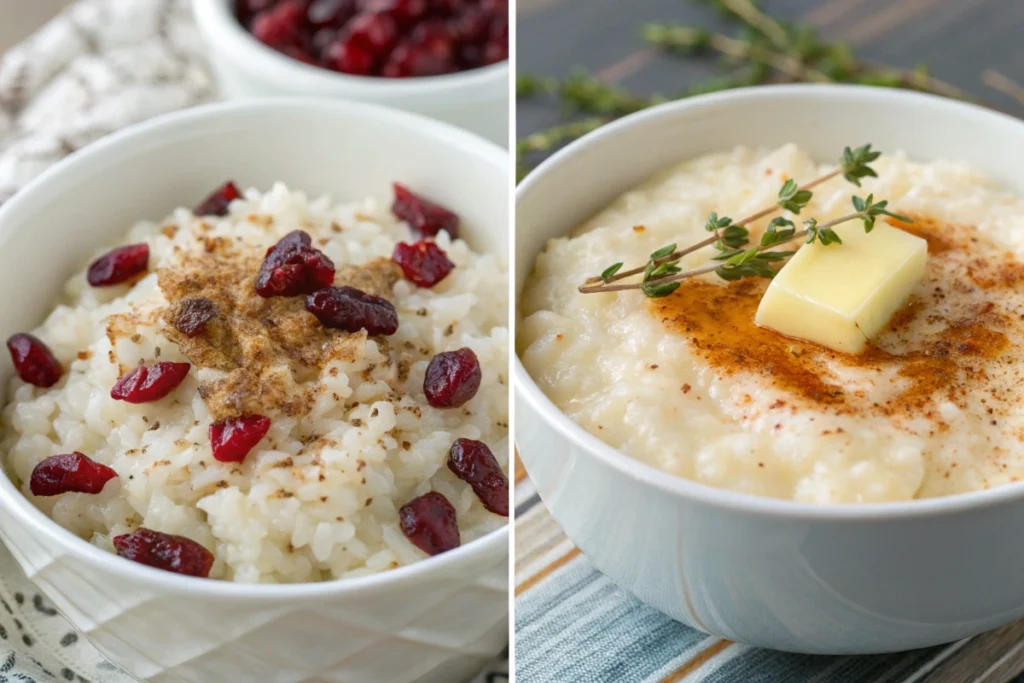
FAQ
Rice pudding and cream of rice may seem similar but are distinctly different. Rice pudding is a sweet dessert traditionally made from cooked rice, milk, and sugar, often flavored with cinnamon or raisins. On the other hand, cream of rice is a smooth, warm cereal created from finely ground rice flour, commonly enriched with nutrients. While rice pudding is enjoyed as a comforting dessert, cream of rice is a versatile breakfast option, especially for those seeking a lighter meal.
They differ in texture, taste, and usage. Rice pudding is creamy, sweet, and often prepared as a dessert. Conversely, cream of rice has a gooey, neutral flavor and is usually eaten as a breakfast or comfort food. Furthermore, rice pudding incorporates milk, sugar, and spices, while cream of rice is simpler, focusing on rice flour and water or milk.
No, they primarily use different ingredients. For instance, rice pudding is made with whole rice grains, milk, sugar, and spices like cinnamon or nutmeg. On the other hand, cream of rice relies mainly on enriched rice flour and liquid, either water or milk. As a result, their flavors and textures are distinct.
Their preparation methods vary significantly. Rice pudding requires cooking rice grains slowly over medium heat with milk, sugar, and spices. This method allows the rice to absorb the flavors and become tender. In contrast, cream of rice involves mixing finely ground rice flour with boiling liquid and stirring it until thickened, which happens much faster. This contrast makes rice pudding more time-intensive but richer in flavor.

